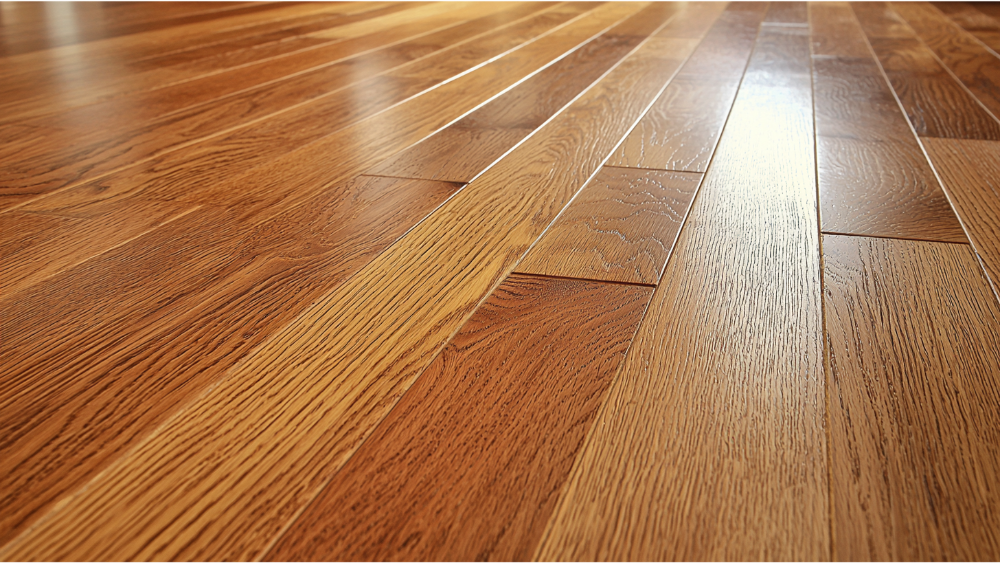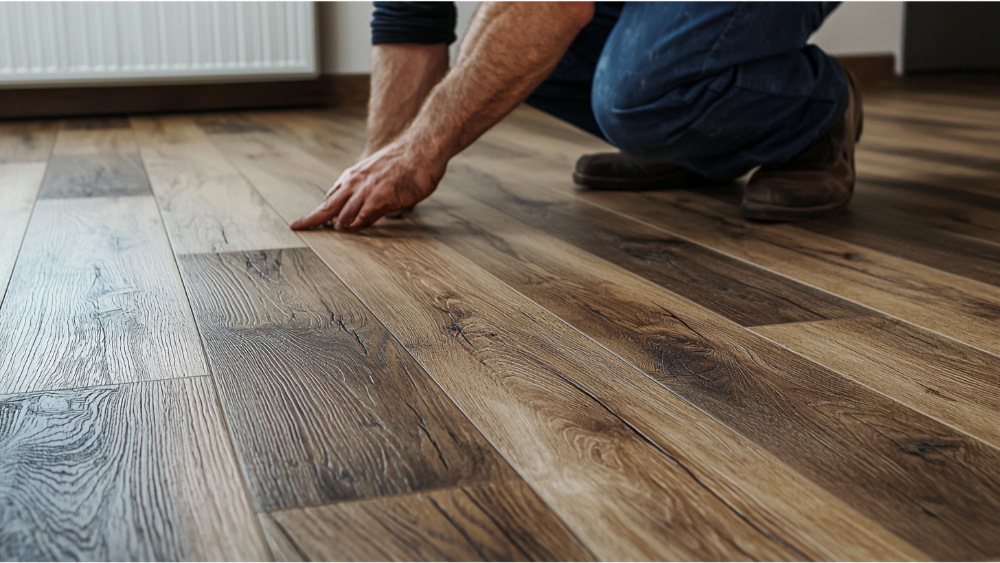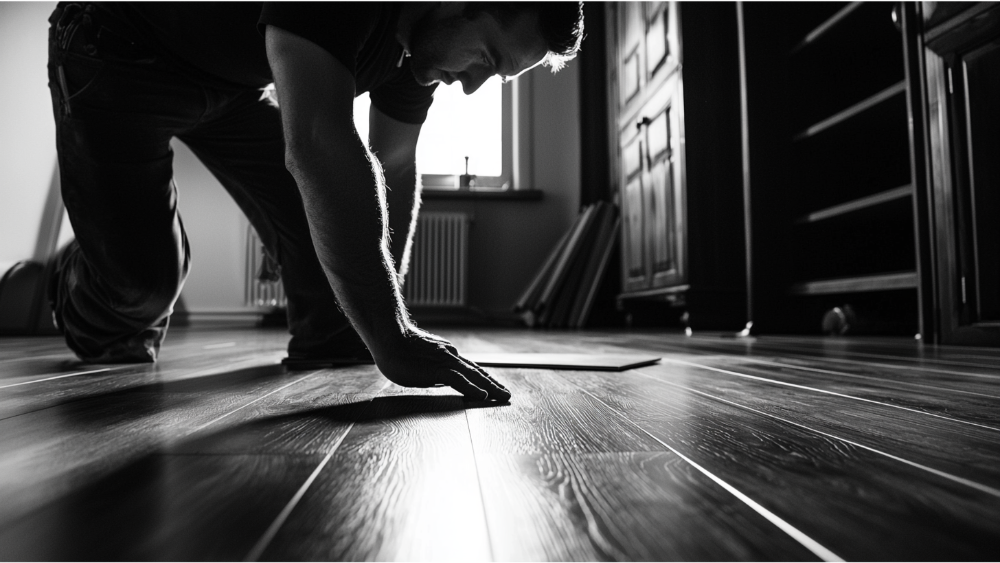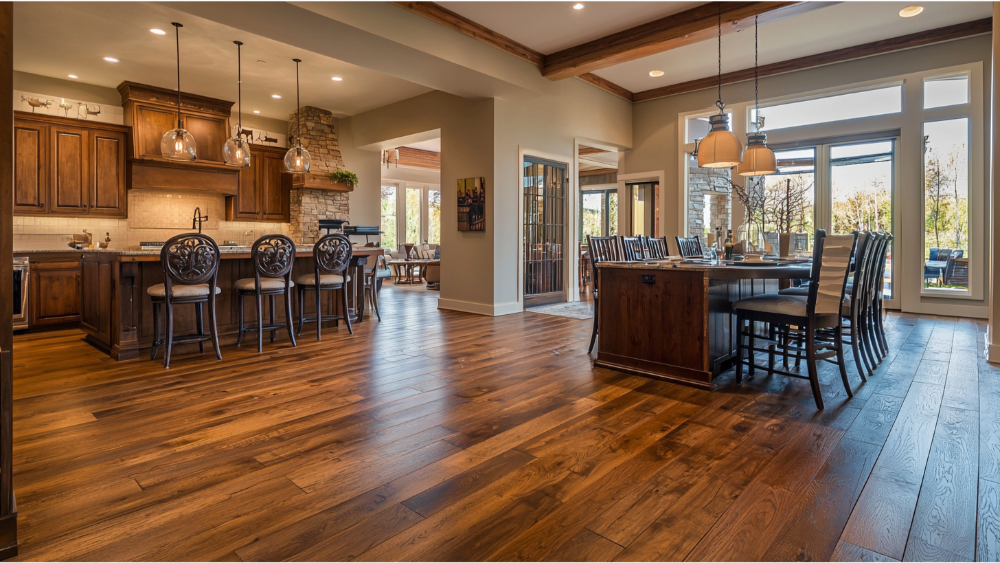Laminate flooring is a popular choice for many homeowners due to its durability, affordability, and attractive appearance. However, when it comes to customizing the look of your floors, you might wonder if staining laminate is a viable option. In this blog, we’ll explore whether staining laminate flooring is possible and what alternatives might work best.
You Cannot Stain Laminate Flooring
The short answer is no, you cannot stain laminate flooring in the traditional sense. Laminate flooring is constructed with a photographic layer that mimics the appearance of wood but is sealed with a protective coating, making it non-porous. Since stains are designed to penetrate porous surfaces like natural wood, they cannot effectively adhere to the surface of laminate. Attempting to stain laminate may result in uneven coloring or damage to the flooring, leaving your floors looking worse than before.
Why Traditional Staining Doesn’t Work

Non-Porous Surface
Laminate flooring is made with a top layer that is non-porous and highly durable to protect it from wear and tear. Traditional stains are designed to seep into porous materials like wood, but with laminate, the surface resists absorption. This means the stain sits on the surface rather than blending in, leading to uneven coverage across the room.
Protective Coating
The laminate’s protective layer acts as a barrier similar to a clear, durable coat of paint over the photographic design. This coating prevents any material, including stains, from adhering effectively to the surface. Even if you attempt to sand the laminate to remove the protective layer, you risk damaging the underlying design and creating an unsightly page-like blank spot.
Design Layer Limitations
Unlike hardwood or engineered wood, laminate flooring’s design is essentially a photographic image that gives the appearance of natural wood or other textures. This page-like print cannot interact with stains as real wood does, meaning any applied stain would not enhance or modify the design but merely obscure it or cause clear visual inconsistencies in the room.
Lack of Durability in Results
Even if you manage to apply a coating of stain, the lack of proper adhesion means the results are not durable. The stained surface would easily chip, scratch, or wear off with foot traffic, especially in high-use areas of the room. This reduces the long-term appeal and functionality of the flooring.
Risk of Damaging the Floor
Attempting to stain laminate flooring can lead to irreversible damage. When sanding or applying stain, you may inadvertently strip away the protective layer or scratch the surface, exposing the underlying design layer. This can result in an uneven, patchy appearance that cannot be repaired and may necessitate replacing the affected planks. Damage from misguided staining attempts can reduce the lifespan of your flooring and negate its original aesthetic appeal.
Alternatives to Change the Color of Laminate Flooring
If you’re looking to change the color or appearance of your laminate flooring, staining might not be the solution, but there are several effective alternatives to consider:
Use Laminate Floor Paint
Specially designed laminate floor paints can provide an entirely new color to your flooring without the need for traditional staining. These paints work well on non-porous surfaces and can be applied evenly to avoid streaks, ensuring a polished look. For best results, use a roller or brush specifically designed for smooth surfaces and apply a sealant to enhance durability. Keep in mind, that it’s essential to sand lightly beforehand and clean thoroughly to ensure proper adhesion.
Apply a Decorative Floor Covering
Rugs or carpet tiles can instantly transform the look and feel of any room without permanently altering the flooring. They come in a variety of colors, patterns, and textures, allowing you to experiment with different ideas for style and design. Decorative coverings can also protect the laminate while adding a pop of color or unique design. For a modern or rustic look, consider an area rug crafted from natural fibers, like jute or sisal, that complements the shine and finish of the laminate.
Install Laminate Overlays or Decals
Laminate overlays and adhesive decals are a quick and cost-effective way to change the appearance of your floors. These products are specifically designed to mimic natural wood, tile, or stone textures and can be applied directly over your existing floor. They provide a uniform finish without worrying about streaks or uneven colors, and they’re typically both durable and removable. This is an ideal solution for temporary updates or renter-friendly renovations.
Buff and Add a Glossy Finish
If you’re satisfied with the overall color but want to enhance the look, buffing the laminate and applying a high-quality laminate polish can work wonders. This process amplifies the shine of the surface, creating a cleaner and more visually appealing look for your room. Be sure to use a product specifically made for laminate flooring to ensure compatibility and avoid streaking during application. Regular maintenance of this glossy finish can keep your floors looking new for years.
Replace Laminate Planks with a New Color or Design
For a long-term solution, you might consider replacing only the top layer of laminate planks with a new color or design. This allows you to log all your color ideas and build the look room by room, ensuring a seamless match to your preferred aesthetic. While this option requires more time and effort, it eliminates the risk of peeling, streaks, or uneven finishes from other methods. With a vast range of laminate options available, you can customize your space to fit your vision perfectly.
Best Practices For This Scenario

Thoroughly Clean the Laminate Surface
Ensure the laminate flooring is free of dust, dirt, or residue before making any changes. Cleaning allows for better adhesion if you are applying paints or overlays and prevents uneven finishes or streaking, which are clear signs of neglect.
Choose the Right Products for Laminate
Always use products specifically designed for laminate, such as laminate floor paint, overlays, or polish. These are optimized for this type of surface and produce consistent results, avoiding the telltale signs of improper material use or application issues.
Test in a Small, Hidden Area First
Before applying any paint, polish, or overlay, test the product in a less noticeable part of the room. This ensures you can check for compatibility and avoid unwanted results that could be sounds of trouble during full-floor application.
Follow the Manufacturer’s Instructions
Whether you’re applying paint, adhesive decals, or polish, adhering to the manufacturer’s guidelines ensures long-lasting and durable results. Ignoring these instructions could lead to poor application and obvious signs of errors like peeling or dull patches.
Mistakes to Avoid For This Scenario
Skipping Surface Preparation
Failing to clean or lightly sand the surface beforehand can result in poor adhesion and uneven application. These are clear signs of a rushed job and may compromise the durability of the final finish.
Using Traditional Stains or Non-Compatible Products
Applying products like wood stains not designed for laminate flooring creates visual inconsistencies and damages the surface. This is one of the most common signs of improper methods leading to unsightly and avoidable outcomes.
Ignoring Wear and Tear Sounds
If the laminate flooring begins to creak or make unusual sounds, especially after applying a topcoat, it could be a sign of poor application or underlying damage. Don’t ignore these signals, as they might indicate a need to remove and restart the process properly.
Overlooking Protective Sealant
If you skip applying a sealant after painting or polishing, the finish may wear off quickly with traffic. Not doing so increases the signs of chipping or fading prematurely, which reduces the appeal of your updated flooring.
Frequently Asked Can You Stain Laminate Flooring Questions

Can I Change the Color of Laminate Flooring?
Yes, it is possible to change the color of laminate flooring with the appropriate methods and materials. Options include using laminate floor paint, overlays, or decals specifically designed for laminate surfaces. These solutions allow for aesthetic updates without compromising the integrity of the flooring. Always prepare the surface thoroughly and follow product instructions for the best results.
What Stain Can You Use on Laminate?
Standard wood stains are not suitable for laminate flooring since laminate does not absorb liquid like natural wood. Instead, you can use specially formulated laminate floor paints or stains that create a protective and colored layer over the surface. These products are designed to adhere to the laminate coating, ensuring a consistent and durable finish. Always ensure the laminate is clean and prepped before applying any stain to achieve the best result.
What Happens If You Stain Laminate?
Attempting to use traditional wood stain on laminate is ineffective because laminate does not absorb liquid like natural wood. Instead, the stain will sit on the surface, leading to an uneven and streaky appearance that can easily peel or chip away. Improper products can damage the laminate’s protective layer, reducing its durability and longevity. To avoid these issues, always use materials specifically designed for laminate surfaces to ensure proper adhesion and a professional finish.
Conclusion
Staining laminate flooring can be a rewarding way to refresh your space, but it requires careful planning and the right materials. By thoroughly preparing the surface and using products specifically designed for laminate, you can achieve a beautiful and durable finish. Avoid common mistakes like skipping cleaning steps or using incompatible products, and always follow manufacturer instructions for the best results. Remember, testing in a small area first can save you from unwanted outcomes and ensure your project turns out just as you envisioned. With proper care and attention to detail, your laminate flooring can be transformed into a stunning focal point, enhancing the overall aesthetic of your home.




